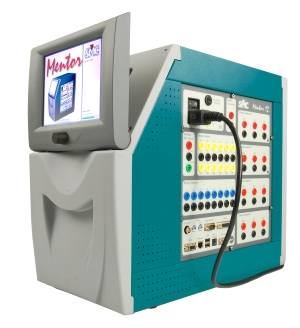How to Test a Relay – EuroSMC Solutions
There is a wide range of relay types, being possible to find in the same place a mix of several relay functions and different generation of relays (electromechanical, electronic, digital relays, or even with IEC 61850 capability), and all need to be tested with the suitable relay test set; sometimes, a typical question of customers is how to test a relay; in fact it is more precise, and rather refers to how to test a relay of X type. But the world is not ideal for the testing engineer, every situation is different, and so how to test a relay depends on more things than just the type of relay or the brand and model.
How to Test a Relay, initial considerations.
The way of how to test a relay will vary depending on the following initial considerations which must firstly be clarified, and that will lead us as well to choose one or another type of relay test equipment:
- Is it a single-phase or three-phase relay? Or can it be tested phase by phase? in general, how many signals and type of them are needed to be simulated? (one current and/or one voltage, 2, 3, 6 or 9 currents, 3, 4 or 6 voltages, 3 currents and 3 voltages, etc); according to these considerations the method of how to test a relay will change and the procedure will be also extended depending on the loops to be tested; accordingly, how to test a relay depends on the number and type of signals available in the relay test set and its flexibility to be easily upgraded when required.

- What level and power of signals is required? Besides the maximum level required, how to test a relay with high impedance requires higher power for the same current level, which the relay test set must supply, or have the flexibility for combining sources and getting the higher power required, and also the same capacity to increase the injection range if required, by joining channels in serial or in parallel; in this case, how to test a relay becomes a question of having flexibility in the relay test equipment to face the different situations regarding level and power requirements, and the capacity to be easily upgraded if it results short for an specific test.
- What protective functions must be tested? (overcurrent, distance, voltage, frequency, differential, etc); for each function, there are many other questions to clarify and the ways of how to test a relay diversify accordingly to the function – whose extension is too long for this small space – but we can mention some initial considerations such as: what device is protecting the differential relay? (transformer, motor, busbar, etc), what is the kind of the inverse time-current curve? (extremely inverse, normal inverse, etc), what impedance zones are activated in the distance relay?, is the directional relay looking forward or reverse?, what are the time tolerances?, and many other previous considerations to how to test a relay on each case.
- Is it required to test some scheme functions? if so, which ones are activated in the relay and with what parameters? (reclose function, breaker failure, etc); in this case, how to test a relay depends on the availability of pre-programmed functions in the supporting relay testing software for each case, without need of complex programming.
- What is the test scenario? In other words, it is required to check for example a couple of points of the characteristic curve or need a complete and thorough analysis of the entire curve? Or the testing target is the relay troubleshooting? Are we in commissioning or in maintenance stage? This will define how to test a relay through different testing tools to be applied, which could range from the need to reproduce fault files (COMTRADE type), or repeatedly use a ramp function to test similar relays, or a simple dynamic bi-state test, or be required a sequence of several states, or only needed to check an instantaneous trip .
- How the relay works? It is required to know the relay operation, which features and functions are enabled and which are not, and which must be deactivated to test a specific function, etc; in short, previously to consider how to test a relay, it is required a deep knowledge of the relay itself, how it works, its tolerances, input/output connections, identify the different trip signals, and also how it is connected to the transformers.
- Practical questions: we must also consider how to test a relay in the different situations which might sometimes require an easy and simple human interface with quick and full manual control and other times, when required, also the automation of the test.
Basically, how to test a relay must adapt to the user and the application, not to adapt the application and the user to the method; this leads to also consider some practical questions such as the human interface, the ease of use and the testing speed provided by the relay test set.

The need for a manual control mode, even when testing the most sophisticated relay, is a must in any relay test set to provide an adapted and efficient way of how to test a relay; during commissioning work, the mayor part of the tests is not systematic, and how to test a relay depends on the installation and the specific functions assigned to the relay under test; this means that the manual control of the relay test set must be intuitive, easy to use, understandable by any operator, and without the need of any external elements from the system.
As a conclusion, how to test a relay has no a direct answer, or the solution is not just to push a button; nevertheless, how to test a relay is more simple when reached to some stage in which all the previous questions are clarified for an specific relay, , and also when some test templates or a series of customized routines of functions have been generated; those ready-to-use routines for each relay type and protective functions, can provide such a level of automation that how to test a relay becomes the closest thing as pushing a button.
There are quite initial considerations to properly face how to test a relay, which leads to different desired functions in the relay test set; EuroSMC provides the wider range of relay test equipment in the market, with all the characteristics and functions previously mentioned as relevant and needed for protective relay testing, in a manual or automatic mode, designed for maximum efficiency, flexibility and simplicity, with the required accuracy and performance to test any kind and type of relays in all situations. How to test a relay becomes an easier question with the well proved solutions and long EuroSMC experience during the last 30 years.
For more information, please check the related EuroSMC products or contact us.
